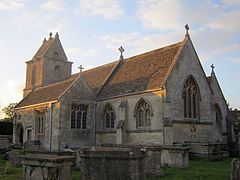South Wraxall
| South Wraxall | |
|---|---|
 St. James parish church |
|
| South Wraxall shown within Wiltshire | |
| Population | 438 (in 2011) |
| OS grid reference | ST833655 |
| Civil parish |
|
| Unitary authority | |
| Ceremonial county | |
| Region | |
| Country | England |
| Sovereign state | United Kingdom |
| Post town | BRADFORD-ON-AVON |
| Postcode district | BA15 |
| Dialling code | 01225 |
| Police | Wiltshire |
| Fire | Dorset and Wiltshire |
| Ambulance | South Western |
| EU Parliament | South West England |
| UK Parliament | |
South Wraxall is a village and a civil parish in Wiltshire, England, 2.5 miles (4.0 km) north of Bradford on Avon. The village is to the east of the B3109 road from Bradford on Avon to Corsham.
The parish includes the village of Lower Wraxall, to the south of South Wraxall; one field separates the two villages. The hamlet of Bradford Leigh is in the southeast of the parish.
The name comes from old English wrocc, meaning a buzzard, although it was also used as a personal name. Its name was first mentioned in 1468 as Suthwroxhall, distinguishing it from North Wraxall which is 6 miles (9.7 km) away. Other spellings of the name included wroxhal (1227) and wrokeshal (1242). Nevertheless, South Wraxall was not mentioned in Domesday Book, as it was grouped in with Bradford on Avon.
The civil parish of South Wraxall was created in 1894, together with the parishes of Holt, Winsley and Limpley Stoke all being allotted from the former parish of Bradford Without.
Most of the buildings of South Wraxall are of the 17th and 18th centuries, built from locally quarried dressed stone, or stone rubble construction with stone slates. Besides quarrying, the main occupation around the area was agriculture, including shepherding; there were also weavers in the early 19th century, and some clothworkers by the mid-19th century.
South Wraxall Manor is a Grade I listed country house dating from the early 15th century. The manor farmhouse is also Grade I listed.
St. James parish church is Grade II* listed. Its tower dates from the 14th century but the rest was rebuilt in 1882-1883 in late Perpendicular Gothic style.
...
Wikipedia

